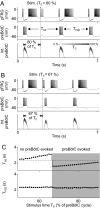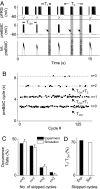Pacemakers handshake synchronization mechanism of mammalian respiratory rhythmogenesis
- PMID: 19008356
- PMCID: PMC2584697
- DOI: 10.1073/pnas.0809377105
Pacemakers handshake synchronization mechanism of mammalian respiratory rhythmogenesis
Abstract
Inspiratory and expiratory rhythms in mammals are thought to be generated by pacemaker-like neurons in 2 discrete brainstem regions: pre-Bötzinger complex (preBötC) and parafacial respiratory group (pFRG). How these putative pacemakers or pacemaker networks may interact to set the overall respiratory rhythm in synchrony remains unclear. Here, we show that a pacemakers 2-way "handshake" process comprising pFRG excitation of the preBötC, followed by reverse inhibition and postinhibitory rebound (PIR) excitation of the pFRG and postinspiratory feedback inhibition of the preBötC, can provide a phase-locked mechanism that sequentially resets and, hence, synchronizes the inspiratory and expiratory rhythms in neonates. The order of this handshake sequence and its progression vary depending on the relative excitabilities of the preBötC vs. the pFRG and resultant modulations of the PIR in various excited and depressed states, leading to complex inspiratory and expiratory phase-resetting behaviors in neonates and adults. This parsimonious model of pacemakers synchronization and mutual entrainment replicates key experimental data in vitro and in vivo that delineate the developmental changes in respiratory rhythm from neonates to maturity, elucidating their underlying mechanisms and suggesting hypotheses for further experimental testing. Such a pacemakers handshake process with conjugate excitation-inhibition and PIR provides a reinforcing and evolutionarily advantageous fail-safe mechanism for respiratory rhythmogenesis in mammals.
Conflict of interest statement
The authors declare no conflict of interest.
Figures





References
-
- Czeisler CA, et al. Stability, precision, and near-24-hour period of the human circadian pacemaker. Science. 1999;284:2177–2181. - PubMed
-
- Ramirez JM, Tryba AK, Pena F. Pacemaker neurons and neuronal networks: An integrative view. Curr Opin Neurobiol. 2004;14:665–674. - PubMed
-
- Strogatz SH, Stewart I. Coupled oscillators and biological synchronization. Sci Am. 1993;269(6):102–109. - PubMed
-
- Matsugu M, Duffin J, Poon CS. Entrainment, instability, quasi-periodicity, and chaos in a compound neural oscillator. J Comput Neurosci. 1998;5:35–51. - PubMed
Publication types
MeSH terms
Substances
Grants and funding
LinkOut - more resources
Full Text Sources

